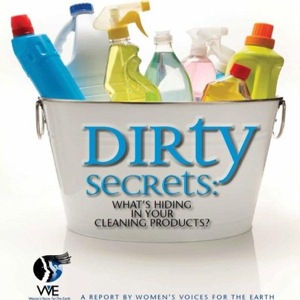 by Janelle Sorensen, Chief Communications Officer, Healthy Child Healthy World
by Janelle Sorensen, Chief Communications Officer, Healthy Child Healthy World
I remember distinctly the first time I truly read a cleaning product label. I had just started learning about how everyday products are largely unregulated in terms of potential health impacts and I thought, “what’s even in the cleaning products I’m using?” I picked up a bottle of Pledge, flipped it over, and over, and nowhere could I find a simple ingredients list.
I was dumbfounded.
I mean, it’s one thing for me to erroneously assume that whatever is in a product is safe, but to me it was totally another to be using something that was made from ingredients I couldn’t even identify. Not only that, I quickly found out I didn’t even have a right to know – manufacturers had no obligation to tell me.
Nothing much has changed since then – except I switched to a combination of homemade and certifiably non-toxic cleaners and, many manufacturers are using misleading packaging that makes consumers think they’re using something natural and safe.
That second point really gets my goat.
Do you know what’s in your cleaners? A new report by Women’s Voices for the Earth, “Dirty Secrets: What’s Hiding in Your Cleaning Products?” reveals some disturbing facts:
- They found hidden toxic chemicals in all products tested. They included carcinogens, reproductive toxins, endocrine disruptors, and allergens.
- Tide Free & Gentle, a detergent marketed to and used by moms for infants’ laundry, contained 1,4-dioxane, a known cancer-causing chemical, as did Bounce Free & Sensitive.
- Simple Green Naturals also contained 1,4-dioxane as well as phthalates, linked to reproductive harm. Simple Green All-Purpose cleaner contained toluene, linked to pregnancy complications.
- Glade Touch Odor contained phthalates, linked to reproductive harm, and galaxolide, linked to hormone disruption.
- Clorox Clean-Up contained chloroform and carbon tetrachloride, both linked to cancer.
- High levels of allergens appeared in fragranced air fresheners, yet there were no warning labels. Allergens were also found in products marketed as fragrance-free.
None of these chemicals were listed on the product’s label.
Consumers deserve to know what chemicals they are being exposed to, so that they can easily avoid products that may cause allergic reactions or serious long-term health impacts like cancer, birth defects, or pregnancy complications. WVE is calling on Congress to pass new federal legislation that requires cleaning product manufacturers to disclose all the ingredients they use in their products directly on the product label.
The Cleaning Products Right to Know Act will require household cleaning products to bear a label including a full list of product ingredients. This is the first step in pressuring companies to create safer cleaning products. Click-through to ask your legislators to support the Cleaning Products Right to Know Act!
What You Can Do in the Meantime:
- Make your own cleaning products! Until we know what’s in the products we buy off the shelf, we can mix our own with safe ingredients like vinegar and baking soda. Here are some great recipes and tips.
- If you are concerned about a cleaning product that you currently use (and like), call the company’s toll-free number and inquire about the problem ingredients discussed in this report. Ask the manufacturer to disclose all of their fragrance ingredients and any contaminants, and ask them to remove any phthalates, musks and toxic contaminants from their products.
Were any of your favorite products on this list? What are your tips for safer cleaning?
I have been saying this for a long time. People are always asking me what “green” cleaners I use, and I always tell them I make my own. Many green cleaners are just a form of “greenwashing”.
My favorite product is not on the list. The safest way to clean without chemicals of any kind is to use steam vapor. If the steam vapor machine is equipped with TANCS then it cleans and kills more germs and faster than any chemical. In fact, steam vapor gets into places that chemicals cannot. It is the heat in the steam that does the work so it just water and heat that cleans and disinfects. No toxic chemicals, no fumes no residues.